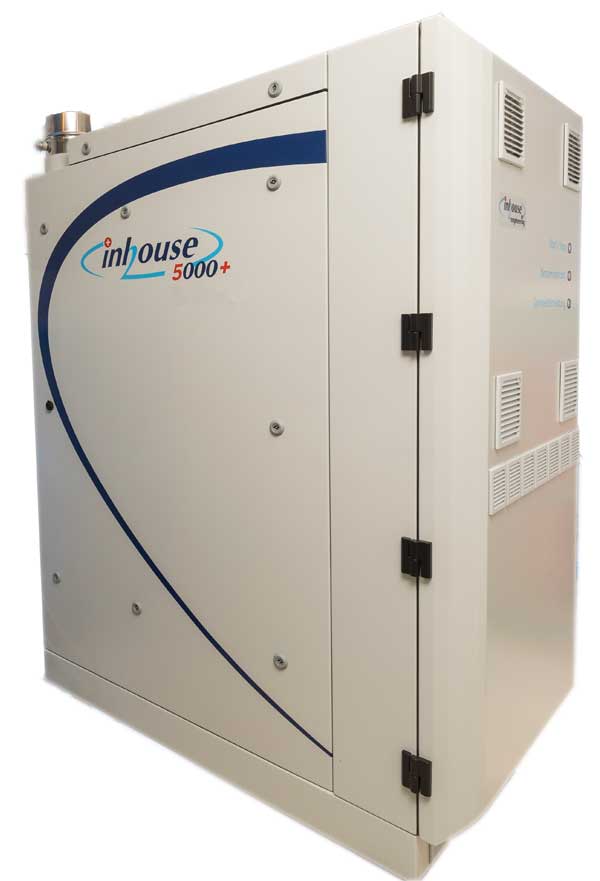Here we answer recurring questions. If your question is not included, please write to us:
Thomas Rothbart
email: t.rothbart@inhouse-engineering.de
tel. +49 30 65 76 25 90
Is the fuel cell CHP inhouse5000+ suitable for my building?
Our fuel cell CHP inhouse5000+ is designed for use in apartment buildings, the commercial segment, in hotels, restaurants, office buildings or retirement homes.
It covers the basic demand for electricity and heat.
We recommend the use of our CHP with an annual heat requirement of more than 100,000 kWh and an annual electrical energy requirement of more than 25,000 kW.
Is the performance (electrical and thermal) sufficient?
During the day, the electrical base load is required about ¾ of the time. This is approx. 300 W for a household with 3 to 4 people.
Our fuel cell CHP can easily supply this base load in an apartment building.
The peak demand is then simply pulled from the network.
So you can cover 75% or more of your electrical energy needs yourself.
The heat is buffered in a hot water storage tank. If that’s not enough, the external peak-load heater kicks in and covers the demand.
Where can I find my consumption data for electrical energy and heat?
You can find out how much electrical energy you use from your utility company’s annual bill. The specification is given in kilowatt hours (kWh).
Your heat requirement roughly corresponds to the consumption of natural gas. You can also see this consumption in the annual bill from your supplier. The information is usually given in kilowatt hours (kWh).
Where does the hydrogen for the fuel cell CHP come from?
Since pure hydrogen for the fuel cell is not yet available via a network, it is produced in our CHP inhouse5000+ by steam reforming natural gas.
This is done on demand and does not require the storage of hydrogen.
The use of natural gas in the CHP also creates CO2 emissions. But, by using electricity and heat, you still save about 30% CO2 compared to the current situation. The current situation means that you draw 100% of your electricity from the German grid and cover your heat requirements with your heating.
What do I need to install the device?
If you already have a gas connection, our inhouse5000+ fuel cell system requires the same connections as a gas condensing boiler.
If there is no hot water tank yet, we recommend installing it in connection with our CHP.
An additional heat generator, such as a condensing boiler, is required to provide the peak load heat. We would be happy to check whether your existing device is suitable. We would be happy to support you in planning the installation.
What about the economy? When does the system pay off?
For the system to operate economically, the highest possible consumption of electricity and heat is required throughout the year, including in the summer months.
Substituting electricity from the grid with self-produced electrical energy enables economical operation.
An exact profitability analysis is always carried out individually for the respective property at inhouse engineering GmbH together with the interested party.
The system usually pays for itself within the full maintenance period of 10 years linked to the subsidy and you then work in the plus.
How stable is the fuel cell CHP system?
In contrast to a motor-driven CHP, the CHP inhouse 5000+ does not work mechanically but electrochemically, i.e. apart from a few electrically moving parts (fans, etc.) there are no mechanically moving components that are susceptible to wear.
The system thus achieves very high runtimes.
What about noise emissions from a fuel cell CHP?
The system works quietly. In contrast to motor-driven CHPs, no vibrations are transmitted to adjacent rooms.
Close the door to your boiler room and you don’t even realize you have a fuel cell.
What about the exhaust gases of a fuel cell CHP?
The exhaust gas mainly consists of water vapour, air from the fuel cell and CO2.
The emissions of sulfur oxides (SOx) or nitrogen oxides (NOx) are far below the legal limits.
And don’t forget, you won’t find any soot or particulate matter in our exhaust gas either.
With which devices can the fuel cell system be combined?
Since every house is slightly different, there are several options here. Coupling with a gas condensing boiler is possible for the heat supply.
But coupling with a heat pump or a photovoltaic system is also a sensible combination. We would be happy to advise you on what makes sense for your application.
How efficient is the fuel cell system compared to conventional technology?
Our fuel cell CHP inhouse5000+ has a high efficiency of approx. 90% thanks to the use of electricity and heat. Only about 10% of the energy cannot be used.
In a modern coal or gas power plant, which usually does not use both, around 60 to 40% of the energy is lost. Added to this are the losses for the transmission of electrical energy from the power plant to your home.
So, a fuel cell CHP is very efficient.
What is the difference between a solid oxide fuel cell (SOFC) and a proton exchange membrane fuel cell (PEM FC)? What are the advantages and disadvantages?
The most significant difference lies in the name. In the solid oxide fuel cell (SOFC), the electrolyte that separates the positive and negative poles from each other consists of a ceramic, while in the PEM fuel cell it consists of a proton-conducting membrane.
Different properties are derived from this. The PEM fuel cell works at 70°C and can therefore start or stop quickly (approx. 1 hour) or modulate the output within a few minutes to adapt to the needs of the house.
The SOFC works at around 700°C and has better electrical efficiency. However, it takes 24 to 48 hours to start and takes significantly longer to modulate the power. A SOFC optimally starts at the beginning of the heating season and is stopped again at the end of the heating season.
Is it worth heating with the fuel cell system only in winter or is the system designed for this?
A fuel cell CHP like the inhouse5000+ pays off because it replaces electrical energy from the grid with self-generated electrical energy. This means that the longer the CHP runs, the faster it pays off.
About 6000 full-load hours or more per year are recommended. The aim should be to operate the CHP unit at full load as far as possible during the heating season and in the transitional period.
In summer, partial load operation or even a temporary shutdown due to a lower heat requirement cannot be avoided.
Can I easily convert a system that runs on natural gas to run on pure hydrogen?
At the moment this is not possible. For pure hydrogen, we offer the inhouse5000+ hydrogen system. It is specially designed for this application and is highly efficient.
However, we are currently working on being able to operate the standard system inhouse5000+ with pure hydrogen.
How long is the service life of such a fuel cell CHP?
The service life is at least 10 years and there is no financial risk thanks to our full maintenance contract.

